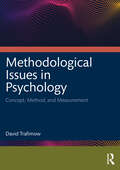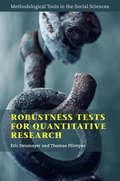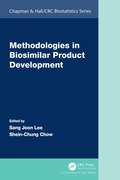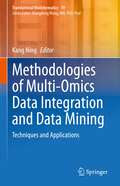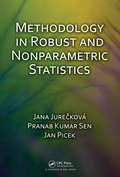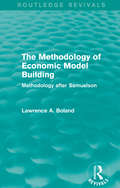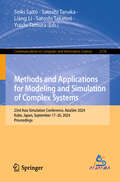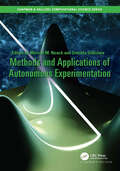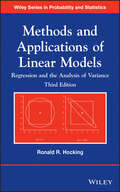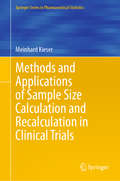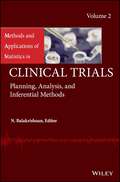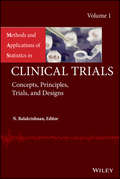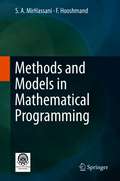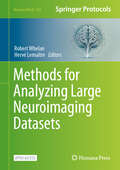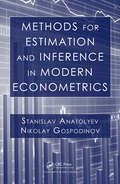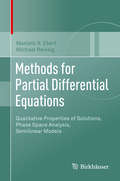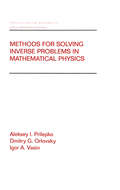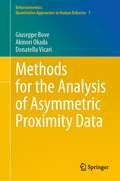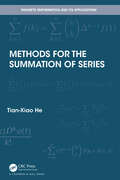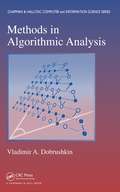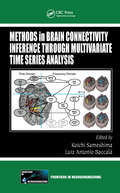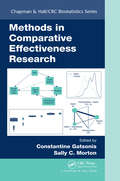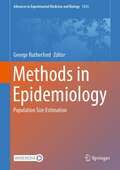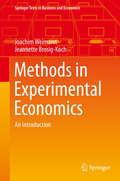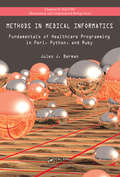- Table View
- List View
Methodological Issues in Psychology: Concept, Method, and Measurement
by David TrafimowMethodological Issues in Psychology is a comprehensive text that challenges current practice in the discipline and provides solutions that are more useful in contemporary research, both basic and applied. This book begins by equipping the readers with the underlying foundation pertaining to basic philosophical issues addressing theory verification or falsification, distinguishing different levels of theorizing, or hypothesizing, and the assumptions necessary to negotiate between these levels. It goes on to specifically focus on statistical and inferential hypotheses including chapters on how to dramatically improve statistical and inferential practices and how to address the replication crisis. Advances to be featured include the author's own inventions, the a priori procedure and gain-probability diagrams, and a chapter about mediation analyses, which explains why such analyses are much weaker than typically assumed. The book also provides an introductory chapter on classical measurement theory and expands to new concepts in subsequent chapters. The final measurement chapter addresses the ubiquitous problem of small effect sizes in psychology and provides recommendations that directly contradict typical thinking and teaching in psychology, but with the consequence that researchers can enjoy dramatically improved effect sizes. Methodological Issues in Psychology is an invaluable asset for students and researchers of psychology. It will also be of vital interest to social science researchers and students in areas such as management, marketing, sociology, and experimental philosophy.
Methodological Tools in the Social Sciences: Robustness Tests for Quantitative Research (Methodological Tools in the Social Sciences)
by Eric Neumayer Thomas PlümperThe uncertainty that researchers face in specifying their estimation model threatens the validity of their inferences. In regression analyses of observational data, the 'true model' remains unknown, and researchers face a choice between plausible alternative specifications. Robustness testing allows researchers to explore the stability of their main estimates to plausible variations in model specifications. This highly accessible book presents the logic of robustness testing, provides an operational definition of robustness that can be applied in all quantitative research, and introduces readers to diverse types of robustness tests. Focusing on each dimension of model uncertainty in separate chapters, the authors provide a systematic overview of existing tests and develop many new ones. Whether it be uncertainty about the population or sample, measurement, the set of explanatory variables and their functional form, causal or temporal heterogeneity, or effect dynamics or spatial dependence, this book provides guidance and offers tests that researchers from across the social sciences can employ in their own research.
Methodologies in Biosimilar Product Development (Chapman & Hall/CRC Biostatistics Series)
by Sang Joon Lee Shein-Chung ChowMethodologies for Biosimilar Product Development covers the practical and challenging issues that are commonly encountered during the development, review, and approval of a proposed biosimilar product. These practical and challenging issues include, but are not limited to the mix-up use of interval hypotheses testing (i.e., the use of TOST) and confidence interval approach, a risk/benefit assessment for non-inferiority/similarity margin, PK/PD bridging studies with multiple references, the detection of possible reference product change over time, design and analysis of biosimilar switching studies, the assessment of sensitivity index for assessment of extrapolation across indications without collecting data from those indications not under study, and the feasibility and validation of non-medical switch post-approval. Key Features: Reviews withdrawn draft guidance on analytical similarity assessment. Evaluates various methods for analytical similarity evaluation based on FDA’s current guidelines. Provides a general approach for the use of n-of-1 trial design for assessment of interchangeability. Discusses the feasibility and validity of the non-medical switch studies. Provides innovative thinking for detection of possible reference product change over time. This book embraces innovative thinking of design and analysis for biosimilar studies, which are required for review and approval of biosimilar regulatory submissions.
Methodologies of Multi-Omics Data Integration and Data Mining: Techniques and Applications (Translational Bioinformatics #19)
by Kang NingThis book features multi-omics big-data integration and data-mining techniques. In the omics age, paramount of multi-omics data from various sources is the new challenge we are facing, but it also provides clues for several biomedical or clinical applications. This book focuses on data integration and data mining methods for multi-omics research, which explains in detail and with supportive examples the “What”, “Why” and “How” of the topic. The contents are organized into eight chapters, out of which one is for the introduction, followed by four chapters dedicated for omics integration techniques focusing on several omics data resources and data-mining methods, and three chapters dedicated for applications of multi-omics analyses with application being demonstrated by several data mining methods. This book is an attempt to bridge the gap between the biomedical multi-omics big data and the data-mining techniques for the best practice of contemporary bioinformatics and the in-depth insights for the biomedical questions. It would be of interests for the researchers and practitioners who want to conduct the multi-omics studies in cancer, inflammation disease, and microbiome researches.
Methodology in Robust and Nonparametric Statistics
by Jana Jureckova Pranab Sen Jan PicekRobust and nonparametric statistical methods have their foundation in fields ranging from agricultural science to astronomy, from biomedical sciences to the public health disciplines, and, more recently, in genomics, bioinformatics, and financial statistics. These disciplines are presently nourished by data mining and high-level computer-based algo
The Methodology of Economic Model Building: Methodology after Samuelson (Routledge Revivals)
by Lawrence A. BolandThe major methodological task for modern economists has been to establish the testability of models. Too often, however, methodological assumptions can make a model virtually impossible to test even under ideal conditions, yet few theorists have examined the requirements and problems of assuring testability in economics. In The Methodology of Economic Model Building, first published in 1989, Lawrence Boland presents the results of a research project that spanned more than twenty years. He examines how economists have applied the philosophy of Karl Popper, relating methodological debates about falsifiability to wider discussions about the truth status of models in natural and social sciences. He concludes that model building in economics reflects more the methodological prescriptions of the economist Paul Samuelson than Popper’s ‘falsificationism’. This title will prove invaluable to both students and researchers, and represents a substantial contribution to debates about the scientific status of economics.
Methods and Applications for Modeling and Simulation of Complex Systems: 23rd Asia Simulation Conference, AsiaSim 2024, Kobe, Japan, September 17–20, 2024, Proceedings (Communications in Computer and Information Science #2170)
by Liang Li Satoshi Tanaka Seiki Saito Satoshi Takatori Yuichi TamuraThis book constitutes the refereed proceedings of the 23rd Asia Simulation Conference on Methods and Applications for Modeling and Simulation of Complex Systems, AsiaSim 2024, held in Kobe, Japan, during September 17–20, 2024. The 28 full papers presented here, were carefully selected and reviewed from 120 submissions. These papers have been categorized into the following topical sections: Methods for Simulation and Modeling; Simulation for Science, Industry and Society; Interdisciplinary Simulation and Machine Learning; Networks and Complex Systems & Modeling, Simulaiton, and Visualization of Digital Twin.
Methods and Applications of Autonomous Experimentation (Chapman & Hall/CRC Computational Science)
by Marcus M. Noack Daniela UshizimaAutonomous Experimentation is poised to revolutionize scientific experiments at advanced experimental facilities. Whereas previously, human experimenters were burdened with the laborious task of overseeing each measurement, recent advances in mathematics, machine learning and algorithms have alleviated this burden by enabling automated and intelligent decision-making, minimizing the need for human interference. Illustrating theoretical foundations and incorporating practitioners’ first-hand experiences, this book is a practical guide to successful Autonomous Experimentation. Despite the field’s growing potential, there exists numerous myths and misconceptions surrounding Autonomous Experimentation. Combining insights from theorists, machine-learning engineers and applied scientists, this book aims to lay the foundation for future research and widespread adoption within the scientific community. This book is particularly useful for members of the scientific community looking to improve their research methods but also contains additional insights for students and industry professionals interested in the future of the field.
Methods and Applications of Linear Models
by Ronald R. HockingPraise for the Second Edition"An essential desktop reference book . . . it should definitely be on your bookshelf." --TechnometricsA thoroughly updated book, Methods and Applications of Linear Models: Regression and the Analysis of Variance, Third Edition features innovative approaches to understanding and working with models and theory of linear regression. The Third Edition provides readers with the necessary theoretical concepts, which are presented using intuitive ideas rather than complicated proofs, to describe the inference that is appropriate for the methods being discussed.The book presents a unique discussion that combines coverage of mathematical theory of linear models with analysis of variance models, providing readers with a comprehensive understanding of both the theoretical and technical aspects of linear models. With a new focus on fixed effects models, Methods and Applications of Linear Models: Regression and the Analysis of Variance, Third Edition also features:Newly added topics including least squares, the cell means model, and graphical inspection of data in the AVE methodFrequent conceptual and numerical examples for clarifying the statistical analyses and demonstrating potential pitfallsGraphics and computations developed using JMP® software to accompany the concepts and techniques presentedNumerous exercises presented to test readers and deepen their understanding of the materialAn ideal book for courses on linear models and linear regression at the undergraduate and graduate levels, the Third Edition of Methods and Applications of Linear Models: Regression and the Analysis of Variance is also a valuable reference for applied statisticians and researchers who utilize linear model methodology.
Methods and Applications of Sample Size Calculation and Recalculation in Clinical Trials (Springer Series in Pharmaceutical Statistics)
by Meinhard KieserThis book provides an extensive overview of the principles and methods of sample size calculation and recalculation in clinical trials. Appropriate calculation of the required sample size is crucial for the success of clinical trials. At the same time, a sample size that is too small or too large is problematic due to ethical, scientific, and economic reasons. Therefore, state-of-the art methods are required when planning clinical trials. Part I describes a general framework for deriving sample size calculation procedures. This enables an understanding of the common principles underlying the numerous methods presented in the following chapters. Part II addresses the fixed sample size design, where the required sample size is determined in the planning stage and is not changed afterwards. It covers sample size calculation methods for superiority, non-inferiority, and equivalence trials, as well as comparisons between two and more than two groups. A wide range of further topics is discussed, including sample size calculation for multiple comparisons, safety assessment, and multi-regional trials. There is often some uncertainty about the assumptions to be made when calculating the sample size upfront. Part III presents methods that allow to modify the initially specified sample size based on new information that becomes available during the ongoing trial. Blinded sample size recalculation procedures for internal pilot study designs are considered, as well as methods for sample size reassessment in adaptive designs that use unblinded data from interim analyses. The application is illustrated using numerous clinical trial examples, and software code implementing the methods is provided. The book offers theoretical background and practical advice for biostatisticians and clinicians from the pharmaceutical industry and academia who are involved in clinical trials. Covering basic as well as more advanced and recently developed methods, it is suitable for beginners, experienced applied statisticians, and practitioners. To gain maximum benefit, readers should be familiar with introductory statistics. The content of this book has been successfully used for courses on the topic.
Methods and Applications of Statistics in Clinical Trials
by N. BalakrishnanA complete guide to the key statistical concepts essential for the design and construction of clinical trialsAs the newest major resource in the field of medical research, Methods and Applications of Statistics in Clinical Trials, Volume 1: Concepts, Principles, Trials, and Designs presents a timely and authoritative reviewof the central statistical concepts used to build clinical trials that obtain the best results. The referenceunveils modern approaches vital to understanding, creating, and evaluating data obtained throughoutthe various stages of clinical trial design and analysis.Accessible and comprehensive, the first volume in a two-part set includes newly-written articles as well as established literature from the Wiley Encyclopedia of Clinical Trials. Illustrating a variety of statistical concepts and principles such as longitudinal data, missing data, covariates, biased-coin randomization, repeated measurements, and simple randomization, the book also provides in-depth coverage of the various trial designs found within phase I-IV trials. Methods and Applications of Statistics in Clinical Trials, Volume 1: Concepts, Principles, Trials, and Designs also features:Detailed chapters on the type of trial designs, such as adaptive, crossover, group-randomized, multicenter, non-inferiority, non-randomized, open-labeled, preference, prevention, and superiority trialsOver 100 contributions from leading academics, researchers, and practitionersAn exploration of ongoing, cutting-edge clinical trials on early cancer and heart disease, mother-to-child human immunodeficiency virus transmission trials, and the AIDS Clinical Trials GroupMethods and Applications of Statistics in Clinical Trials, Volume 1: Concepts, Principles, Trials, and Designs is an excellent reference for researchers, practitioners, and students in the fields of clinicaltrials, pharmaceutics, biostatistics, medical research design, biology, biomedicine, epidemiology,and public health.
Methods and Applications of Statistics in Clinical Trials, Volume 1: Concepts, Principles, Trials, and Designs (Methods and Applications of Statistics)
by N. BalakrishnanA complete guide to the key statistical concepts essential for the design and construction of clinical trials As the newest major resource in the field of medical research, Methods and Applications of Statistics in Clinical Trials, Volume 1: Concepts, Principles, Trials, and Designs presents a timely and authoritative reviewof the central statistical concepts used to build clinical trials that obtain the best results. The referenceunveils modern approaches vital to understanding, creating, and evaluating data obtained throughoutthe various stages of clinical trial design and analysis. Accessible and comprehensive, the first volume in a two-part set includes newly-written articles as well as established literature from the Wiley Encyclopedia of Clinical Trials. Illustrating a variety of statistical concepts and principles such as longitudinal data, missing data, covariates, biased-coin randomization, repeated measurements, and simple randomization, the book also provides in-depth coverage of the various trial designs found within phase I-IV trials. Methods and Applications of Statistics in Clinical Trials, Volume 1: Concepts, Principles, Trials, and Designs also features: Detailed chapters on the type of trial designs, such as adaptive, crossover, group-randomized, multicenter, non-inferiority, non-randomized, open-labeled, preference, prevention, and superiority trials Over 100 contributions from leading academics, researchers, and practitioners An exploration of ongoing, cutting-edge clinical trials on early cancer and heart disease, mother-to-child human immunodeficiency virus transmission trials, and the AIDS Clinical Trials Group Methods and Applications of Statistics in Clinical Trials, Volume 1: Concepts, Principles, Trials, and Designs is an excellent reference for researchers, practitioners, and students in the fields of clinicaltrials, pharmaceutics, biostatistics, medical research design, biology, biomedicine, epidemiology,and public health.
Methods and Models in Mathematical Programming
by F. Hooshmand S. A. MirHassaniThis book focuses on mathematical modeling, describes the process of constructing and evaluating models, discusses the challenges and delicacies of the modeling process, and explicitly outlines the required rules and regulations so that the reader will be able to generalize and reuse concepts in other problems by relying on mathematical logic.Undergraduate and postgraduate students of different academic disciplines would find this book a suitable option preparing them for jobs and research fields requiring modeling techniques. Furthermore, this book can be used as a reference book for experts and practitioners requiring advanced skills of model building in their jobs.
Methods for Analyzing Large Neuroimaging Datasets (Neuromethods #218)
by Robert Whelan Hervé LemaîtreThis Open Access volume explores the latest advancements and challenges in standardized methodologies, efficient code management, and scalable data processing of neuroimaging datasets. The chapters in this book are organized in four parts. Part One shows the researcher how to access and download large datasets, and how to compute at scale. Part Two covers best practices for working with large data, including how to build reproducible pipelines and how to use Git. Part Three looks at how to do structural and functional preprocessing data at scale, and Part Four describes various toolboxes for interrogating large neuroimaging datasets, including machine learning and deep learning approaches. In the Neuromethods series style, chapters include the kind of detail and key advice from the specialists needed to get successful results in your laboratory. Authoritative and comprehensive, Methods for Analyzing Large Neuroimaging Datasets is a valuable resource that will help researchers obtain the practical knowledge necessary for conducting robust and reproducible analyses of large neuroimaging datasets.
Methods for Estimation and Inference in Modern Econometrics
by Stanislav Anatolyev Nikolay GospodinovThis book covers important topics in econometrics. It discusses methods for efficient estimation in models defined by unconditional and conditional moment restrictions, inference in misspecified models, generalized empirical likelihood estimators, and alternative asymptotic approximations. The first chapter provides a general overview of established nonparametric and parametric approaches to estimation and conventional frameworks for statistical inference. The next several chapters focus on the estimation of models based on moment restrictions implied by economic theory. The final chapters cover nonconventional asymptotic tools that lead to improved finite-sample inference.
Methods for Partial Differential Equations: Qualitative Properties Of Solutions, Phase Space Analysis, Semilinear Models
by Marcelo R. Ebert Michael ReissigThis book provides an overview of different topics related to the theory of partial differential equations. Selected exercises are included at the end of each chapter to prepare readers for the “research project for beginners” proposed at the end of the book. It is a valuable resource for advanced graduates and undergraduate students who are interested in specializing in this area.The book is organized in five parts:In Part 1 the authors review the basics and the mathematical prerequisites, presenting two of the most fundamental results in the theory of partial differential equations: the Cauchy-Kovalevskaja theorem and Holmgren's uniqueness theorem in its classical and abstract form. It also introduces the method of characteristics in detail and applies this method to the study of Burger's equation.Part 2 focuses on qualitative properties of solutions to basic partial differential equations, explaining the usual properties of solutions to elliptic, parabolic and hyperbolic equations for the archetypes Laplace equation, heat equation and wave equation as well as the different features of each theory. It also discusses the notion of energy of solutions, a highly effective tool for the treatment of non-stationary or evolution models and shows how to define energies for different models.Part 3 demonstrates how phase space analysis and interpolation techniques are used to prove decay estimates for solutions on and away from the conjugate line. It also examines how terms of lower order (mass or dissipation) or additional regularity of the data may influence expected results.Part 4 addresses semilinear models with power type non-linearity of source and absorbing type in order to determine critical exponents: two well-known critical exponents, the Fujita exponent and the Strauss exponent come into play. Depending on concrete models these critical exponents divide the range of admissible powers in classes which make it possible to prove quite different qualitative properties of solutions, for example, the stability of the zero solution or blow-up behavior of local (in time) solutions. The last part features selected research projects and general background material.
Methods for Solving Inverse Problems in Mathematical Physics (Chapman & Hall/CRC Pure and Applied Mathematics)
by Global Express Ltd. Co. Aleksey I. Prilepko Dmitry G. Orlovsky Igor A. VasinDeveloping an approach to the question of existence, uniqueness and stability of solutions, this work presents a systematic elaboration of the theory of inverse problems for all principal types of partial differential equations. It covers up-to-date methods of linear and nonlinear analysis, the theory of differential equations in Banach spaces, app
Methods for the Analysis of Asymmetric Proximity Data (Behaviormetrics: Quantitative Approaches to Human Behavior #7)
by Giuseppe Bove Akinori Okada Donatella VicariThis book provides an accessible introduction and practical guidelines to apply asymmetric multidimensional scaling, cluster analysis, and related methods to asymmetric one-mode two-way and three-way asymmetric data. A major objective of this book is to present to applied researchers a set of methods and algorithms for graphical representation and clustering of asymmetric relationships. Data frequently concern measurements of asymmetric relationships between pairs of objects from a given set (e.g., subjects, variables, attributes,…), collected in one or more matrices. Examples abound in many different fields such as psychology, sociology, marketing research, and linguistics and more recently several applications have appeared in technological areas including cybernetics, air traffic control, robotics, and network analysis. The capabilities of the presented algorithms are illustrated by carefully chosen examples and supported by extensive data analyses. A review of the specialized statistical software available for the applications is also provided. This monograph is highly recommended to readers who need a complete and up-to-date reference on methods for asymmetric proximity data analysis.
Methods for the Summation of Series (Discrete Mathematics and Its Applications)
by Tian-Xiao HeThis book presents methods for the summation of infinite and finite series and the related identities and inversion relations. The summation includes the column sums and row sums of lower triangular matrices. The convergence of the summation of infinite series is considered. The author’s focus is on symbolic methods and the Riordan array approach. In addition, this book contains hundreds summation formulas and identities, which can be used as a handbook for people working in computer science, applied mathematics, and computational mathematics, particularly, combinatorics, computational discrete mathematics, and computational number theory. The exercises at the end of each chapter help deepen understanding. Much of the materials in this book has never appeared before in textbook form. This book can be used as a suitable textbook for advanced courses for high lever undergraduate and lower lever graduate students. It is also an introductory self-study book for re- searchers interested in this field, while some materials of the book can be used as a portal for further research.
Methods in Algorithmic Analysis (Chapman & Hall/CRC Computer and Information Science Series)
by Vladimir A. DobrushkinExplores the Impact of the Analysis of Algorithms on Many Areas within and beyond Computer ScienceA flexible, interactive teaching format enhanced by a large selection of examples and exercisesDeveloped from the author’s own graduate-level course, Methods in Algorithmic Analysis presents numerous theories, techniques, and methods used for analyzing algorithms. It exposes students to mathematical techniques and methods that are practical and relevant to theoretical aspects of computer science.After introducing basic mathematical and combinatorial methods, the text focuses on various aspects of probability, including finite sets, random variables, distributions, Bayes’ theorem, and Chebyshev inequality. It explores the role of recurrences in computer science, numerical analysis, engineering, and discrete mathematics applications. The author then describes the powerful tool of generating functions, which is demonstrated in enumeration problems, such as probabilistic algorithms, compositions and partitions of integers, and shuffling. He also discusses the symbolic method, the principle of inclusion and exclusion, and its applications. The book goes on to show how strings can be manipulated and counted, how the finite state machine and Markov chains can help solve probabilistic and combinatorial problems, how to derive asymptotic results, and how convergence and singularities play leading roles in deducing asymptotic information from generating functions. The final chapter presents the definitions and properties of the mathematical infrastructure needed to accommodate generating functions.Accompanied by more than 1,000 examples and exercises, this comprehensive, classroom-tested text develops students’ understanding of the mathematical methodology behind the analysis of algorithms. It emphasizes the important relation between continuous (classical) mathematics and discrete mathematics, which is the basis of computer science.
Methods in Brain Connectivity Inference through Multivariate Time Series Analysis (Frontiers in Neuroengineering Series)
by Koichi Sameshima Luiz Antonio BaccaláInterest in brain connectivity inference has become ubiquitous and is now increasingly adopted in experimental investigations of clinical, behavioral, and experimental neurosciences. Methods in Brain Connectivity Inference through Multivariate Time Series Analysis gathers the contributions of leading international authors who discuss different time series analysis approaches, providing a thorough survey of information on how brain areas effectively interact. Incorporating multidisciplinary work in applied mathematics, statistics, and animal and human experiments at the forefront of the field, the book addresses the use of time series data in brain connectivity interference studies. Contributors present codes and data examples to back up their methodological descriptions, exploring the details of each proposed method as well as an appreciation of their merits and limitations. Supplemental material for the book, including code, data, practical examples, and color figures is supplied in the form of downloadable resources with directories organized by chapter and instruction files that provide additional detail.The field of brain connectivity inference is growing at a fast pace with new data/signal processing proposals emerging so often as to make it difficult to be fully up to date. This consolidated panorama of data-driven methods includes theoretical bases allied to computational tools, offering readers immediate hands-on experience in this dynamic arena.
Methods in Comparative Effectiveness Research (Chapman & Hall/CRC Biostatistics Series)
by Constantine Gatsonis Sally C. MortonComparative effectiveness research (CER) is the generation and synthesis of evidence that compares the benefits and harms of alternative methods to prevent, diagnose, treat, and monitor a clinical condition or to improve the delivery of care (IOM 2009). CER is conducted to develop evidence that will aid patients, clinicians, purchasers, and health policy makers in making informed decisions at both the individual and population levels. CER encompasses a very broad range of types of studies—experimental, observational, prospective, retrospective, and research synthesis. This volume covers the main areas of quantitative methodology for the design and analysis of CER studies. The volume has four major sections—causal inference; clinical trials; research synthesis; and specialized topics. The audience includes CER methodologists, quantitative-trained researchers interested in CER, and graduate students in statistics, epidemiology, and health services and outcomes research. The book assumes a masters-level course in regression analysis and familiarity with clinical research.
Methods in Epidemiology: Population Size Estimation (Advances in Experimental Medicine and Biology #1333)
by George RutherfordThis book describes the variety of direct and indirect population size estimation (PSE) methods available along with their strengths and weaknesses. Direct estimation methods, such as enumeration and mapping, involve contact with members of hard-to-reach groups. Indirect methods have practical appeal because they require no contact with members of hard-to-reach groups. One indirect method in particular, network scale-up (NSU), has several strengths over other PSE methods: It can be applied at a province/country level, it can estimate size of several hard-to-reach population in a single study, and it is implemented with members of the general population rather than members of hard-to-reach groups.The book discusses methods to collect, analyze, and adjust results and presents methods to triangulate and finalize PSEs.
Methods in Experimental Economics: An Introduction (Springer Texts in Business and Economics)
by Joachim Weimann Jeannette Brosig-KochThis textbook provides a hands-on and intuitive overview of the methodological foundations of experimental economics. Experimental economic research has been an integral part of economic science for quite some time and is gaining more and more attention in related disciplines. The book addresses the design and execution of experiments, the evaluation of experimental data and the equipment of an experimental laboratory. It illustrates the challenges involved in designing and conducting experiments and helps the reader to address them in practice.
Methods in Medical Informatics: Fundamentals of Healthcare Programming in Perl, Python, and Ruby (Chapman & Hall/CRC Computational Biology Series)
by Jules J. BermanToo often, healthcare workers are led to believe that medical informatics is a complex field that can only be mastered by teams of professional programmers. This is simply not the case. With just a few dozen simple algorithms, easily implemented with open source programming languages, you can fully utilize the medical information contained in clini
